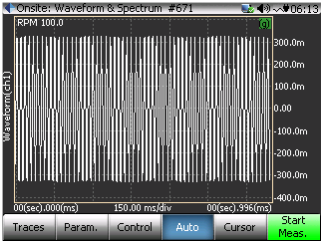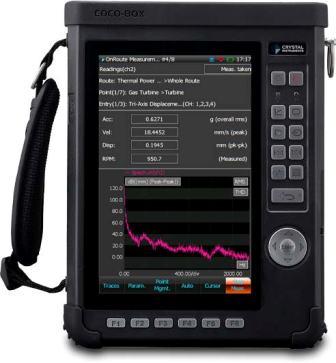Handheld Data Acquisition
General Handheld Data Acquisition Operations
The Crystal Instruments CoCo series are portable devices for handheld data acquisition, vibration monitoring, and predictive maintenance applications. The handheld data acquisition system consists of a CoCo analyzer and the Engineering Data Management (EDM) software. The CoCo is used to make field measurements and the EDM software in Route and OnSite Mode is used to setup the CoCo hardware and define routes before field measurements, and to download data from the CoCo to analyze and archive afterwards.
EDM has a unique user interface that emphasizes graphical tools. The layout can be configured and customized to meet your specific needs. The software has been designed to make using the CoCo a streamlined process that makes measuring, analyzing, and documenting your work easier than ever.
Types of Measurements
The CoCo measures several different types of data during handheld data acquisition operations, including: gage readings, time waveforms, FFT spectra, and demodulation spectra.
Gage Readings for Handheld Data Acquisition
Gage readings are input manually by the user while collecting data on a Route. In addition, Readings are numerically displayed values such as time averaged RMS, peak to peak amplitude, and peak amplitude signals based on live data being acquired, calculated, and displayed by Route and OnSite Mode.
Figure 1: Reading Display
Waveforms Collected During Handheld Data Acquisition
A waveform is a time stream recording of the sampled sensor signal. A typical waveform shows the acceleration or velocity of a machine vibration as an oscillating function of time.
Figure 2: Time Waveform
Spectra Collected During Handheld Data Acquisition
During handheld data acquisition, spectra show the recorded signal in the frequency domain using FFT processing. It is useful for identifying the frequency components of the signal and for monitoring the levels of different frequencies whose values might predict a machine fault. For example, unbalance in a machine will show up as a high amplitude peak at the running speed of the machine. In a large fan, as dirt builds up on the blower cage, this unbalance will generate a higher amplitude peak over time which can be trended. Other faults have other identifying characteristics.
Figure 3: FFT Spectrum
Demodulated Waveforms Collected During Handheld Data Acquisition
The demodulation process looks for repetitive patterns created by impact events that lie embedded within the time waveform. The process works by extracting the low amplitude, high frequency impact signals and then tracing an 'envelope' around these signals to identify them as repetitions of the same fault. The resulting waveform, with the low frequency data removed, will now clearly show the high frequency impact signals and harmonics.
Demodulated Spectra Collected During Handheld Data Acquisition
Demodulated Spectra is computed from the Demodulated Waveform. Demodulated Spectrum is useful as an early warning device, as it detects bearing tones before they are visible in a normal acceleration spectrum. See Appendix 1 for more information.
Tachometer Signal Usage During Handheld Data Acquisition
During data acquisition, a tachometer signal can be used to measure the rotating speed of the equipment. It provides a more accurate method of recording the speed than manually entering a nominal value. A tachometer signal can be recorded from any device that generates a 0 ? 10 V (or less) pulse with one or more pulses per revolution. Typical tachometer sensors include proximity sensors, optical sensors, magnetic sensors, etc.
Recommended for Handheld Data Acquisition
The CoCo is the first battery powered handheld data acquisition system that matches the performance and functionality of high-end systems. The CoCo is equipped with 2, 4, 8, or 16 input channels and can accurately measure and record both dynamic and static signals. The mass flash memory can record 8 channels of streaming signals simultaneously up to 102.4 kHz. An embedded signal source channel provides various signal output waveforms that are synchronized with the input sampling rate.
The CoCo excels in both dynamic and static measurements. When used for dynamic measurements, the input channels offer extremely high-quality dynamic range, signal to noise ratio, cross channel gain match, phase match, and spectrum flatness over an analysis frequency range up to 46.08 kHz. When it is used to measure static or quasi-static signals, it offers very high accuracy at DC or near DC frequency.
For VDC applications the CoCo data is stored and managed by an SQL relational database. For DSA applications the CoCo software stores and organizes the data in the popular ASAM-ODS standard. Data may be exchanged with other data formats such as UFF, BUFF, NI-TDM, ASCII, MATLAB, Excel, or WAV (exporting as WAV is limited to time waveform data recordings). The ASAM-ODS data standard provides ultimate flexibility and version compatibility. ASAM-ODS data standard is widely supported by the automotive industry and is expanding to aerospace and other areas.
The handheld data acquisition system is equipped with two USB ports, 100Base-T Ethernet, SD card interface, audio input/output, 5.7 inch color LCD display, and a keypad. You can connect the CoCo to a PC, download files and upgrade the software through several means of network connection. The user interface of CoCo is specifically designed for easy operation while it maintains the capability of providing a wide variety of analysis functions.
The CoCo weighs less than 1.7 kg. Advanced thermal design eliminates the need for a cooling fan reducing operating noise. The fully charged battery life is up to 10 hours, depending on configuration and usage. An AC adapter can be used any time to charge the device while simultaneously recording and processing data.
Compared to handheld data acquisition systems and signal analyzers from other providers, the CoCo delivers higher dynamic range, accuracy, and recording throughput rate and real-time analysis performance. It also provides more powerful communication peripherals.




